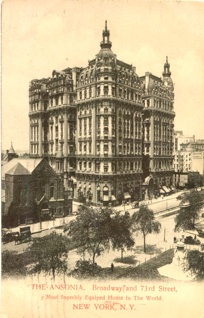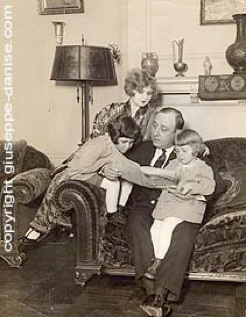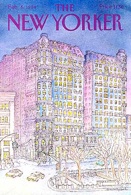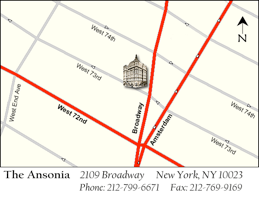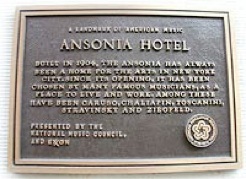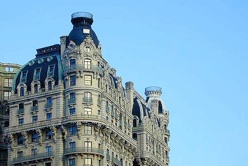Ansonia hotel, residenza di Giuseppe Danise e della sua famiglia.
Ansonia hotel, Giuseppe Danise’s (and family) home.
2109 Broadway (73rd St. & 74th St.), NY 10023-2106
L'Ansonia Hotel è probabilmente uno dei più importanti edifici storici del west side. Fu progettato in stile French Beaux Arts dallo scultore e architetto francese Paul E. M. DuBoy. I lavori per la sua costruzione iniziarono nel 1899 e furono necessari cinque anni per completarli.
Caratteristiche architettoniche particolari sono le torri tonde sormontate da cupole agli angoli ed il tetto mansardato.Questo hotel ha qualcosa in comune con il Chelsea Hotel. Mentre quest'ultimo ha la particolarità di essere stato spesso preferito da artisti letterati, l'Ansonia Hotel è stato sempre molto frequentato da musicisti. Tra questi Enrico Caruso, Arturo Toscanini, Igor Stravinsky, Leopold Auer, Feodor Chaliapin, Lily Pons, Mischa Elman, Geraldine Farrar, Lauritz Melchior, Ezio Pinza e Tito Schipa.E ovviamente anche Giuseppe Danise.
Mr. Stokes' Marvelous Creation
Ansonia was built by Phelps-Dodge copper heir William Earl Dodge Stokes, a noted builder and one of the leading developers of Riverside Drive, the Upper West Side, and the Broadway Mall. It was designed in accordance with his specific
instructions by the prominent European architect Emile Paul DuBoy, who also designed the Soldiers' and Sailors' Monument on Riverside Drive at 89th Street. Construction began in 1899, and upon its completion in 1904 (when it was named for the Connecticut community founded by Stoke's grandfather, Anson Green Phelps of the Ansonia Brass & Copper Company), The Ansonia was the largest residential hotel of its day. Legend has it that Mr. Stokes wanted The Ansonia to be much taller, but stopped at the 17th floor because he liked the view.
A Hotel Unlike Any Other
In addition to 400 original residential suites and 1,218 rooms, The Ansonia had every luxury of the period, including a pneumatic tube system that
allowed tenants to exchange messages and gossip; Turkish baths; six passenger elevators, as well as large service elevators and dumbwaiters for delivery to apartment kitchens; several restaurants decorated in the Gilded-Age style of Louis XIV; two swimming pools, including the world's largest indoor pool; basement shops; fresh eggs, courtesy of the chickens in Mr. Stokes' rooftop farm; and seals that frolicked in its lobby fountain. A list of The Ansonia's past guests and residents reads like a "who's who" of the art and entertainment world. Some of its most
famous residents included musical immortals Enrico Caruso, Sergei Rachmaninoff, Igor Stravinsky, Arturo Toscanini, Gustave Mahler, Yehudi Menuhin, Lily Pons and Ezio Pinza; theatrical notables Sol Hurok, Florenz Ziegfeld, Sarah Bernhardt, Bille Burke, Moss Hart, Tony Curtis and Paul Sorvino; sports legends Babe Ruth and Jack Dempsey; and writers Elmer Rice, W.L. Stodard and Theodore Dreiser.
Glamour…Eccentricity…Intrigue
From the moment of its completion, The Ansonia inspired a unique aura of glamour, eccentricity and intrigue. Legends about its famous residents abound: Danish tenor Lauritz Melchior used its halls for target practice; Theodore Dreiser wrote An American Tragedy during his residence; the Secret Service foiled a German plot to blow it up on the eve of the Atlantic Fleet's Naval ball just before World War I; The Ansonia was the site of the Chicago White Sox conspiracy to throw the 1919 World Series; the building's vast size permitted ladies man Flo Ziegfeld to keep his wife and mistress in separate apartments;
Bette Midler and Barry Manilow began their careers at the legendary Continental Baths; and Babe Ruth's neighbors were grateful for its thick, soundproof walls after living in The Ansonia inspired him to take up
the saxophone.
What a Babe!
The Ansonia was Babe Ruth's first home in New York after the owner of the Boston Red Sox "sold" him to the Yankees to raise money to invest in the original production of No No Nanette in order to impress his girlfriend. This is the origin of "The Curse of the Bambino," which many believe is the reason the Red Sox have never won a World Series. Living the life of a bachelor, Babe Ruth sowed his wild oats at The Ansonia, then New York's most elegant residential hotel. Legend has it that he chased women up and down the halls and had one employee dedicated to sorting his fan mail--"Keep the dough and the pictures of the broads, and throw the rest out," were his reputed instructions. He also became the beloved linchpin of "murderers row," the 1927 Yankees team that included Lou Gerhrig.
Beloved Landmark and Movie Star
The Ansonia is listed in the National Registry of Historic Places and was designated as a New York City landmark on March 14, 1972 by the New York Landmarks Preservation Commission, which called its effect one of "joyous exuberance profiled against the sky." The Ansonia's
landmark designation was supported by a petition with over 25,000 signatures. The Ansonia has been in numerous films and commercials. It made its film debut in The Sunshine Boys. After starring in Single White Female, it was featured in the Natalie Cole video Take A Look, played home to Michael Keaton and Marissa Tomei in Ron Howard's The Paper, and had a cameo role in White Man's Burden, Gregory Hines' directorial debut.
Ansonia Apartment Hotel
Location: 2109 Broadway between 73rd and 74th
Streets, New York, New York
Architect: Graves and Doboy
Date Completed: 1904
The Ansonia is typical of the standard of luxury applied to turn of the century apartment buildings on Manhattan's Upper West Side.
With seventeen stories and 300 suites, the Ansonia is covered with ornament and balconies, marked by beautifully scaled corner towers, and topped by mansards in the very best French tradition.
Despite the proliferation of ornamentation, the effect of the whole is one of lightness, grace and elegance. The tiers of windows, recessed courts and rounded towers establish a sense of the vertical, while a series of balconies emphasize the horizontal.
The extensive ornamentation and lacy ironwork combined with the smooth panels of the brick work creates a dramatically elegant surface.
The Ansonia was constructed with heavy, all masonry fireproof materials with heavy interior partitions to separate the individual apartments, thus making them virtually soundproof as well.




